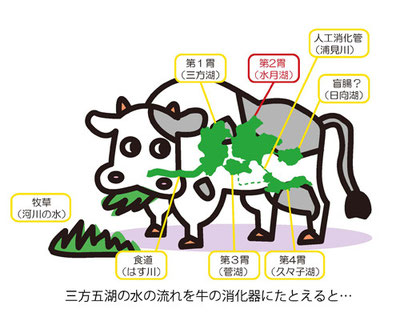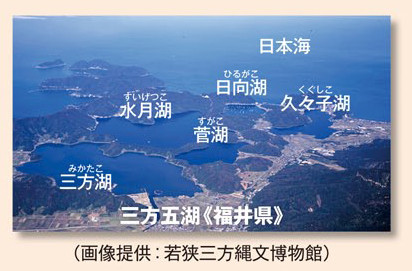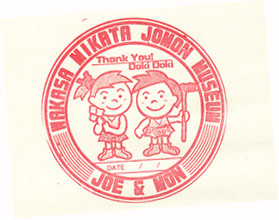2014年8月発行

若狭町・美浜町にまたがる名勝三方五湖。
各湖は、水路や運河で、まるで牛の胃袋のようにつながり、
川のように水が流れ、若狭湾に注ぐ。
その中流にあたる最大の湖・水月湖の底には、
地球がつけた「日記帳」が今も残っているのだ。
右手に三方湖を見ながら、国道162号線を北に向かうと、
いくつかの集落を経て、やがて三方湖の対岸が迫ってくる。
狭い水路を経て再び水面が広くなり、水月湖に入る。
水月湖は、深さ34m、幅2㎞の横断面がフライパンのような形の湖である。
周囲の山々は絵本に出てくるようなこんもりした形で、
強い風が湖面を波立たせることはあまりない。
これが、「日記帳」が残される大きな理由の一つなのだ。
この「日記帳」とは何か。
樹木は、1年1年の生長記録を年輪として残すが、
同じく水月湖の湖底土にも、堆積物の縞模様として残されている。
それが「年縞(ねんこう)」である。
ボーリング調査の結果、
現在の湖底から過去7万年前まで遡ることが確かめられた。
過去7万年間、湖の周りの木々から飛んだ花粉が、水面に落ち、
年縞に取り込まれていた。花粉は、どんな木々が生えていたか、
ひいてはどんな気候環境であったかの指標なので、
この日記帳をめくれば、過去の気候環境もわかるのである。
また、洪水や地震などがおこると、
湖底にはふだんよりも多くの泥が積もるので
災害の履歴も正確に記録しているとも言える。
7万年分の年縞は、地球にしてみれば、まめにつけた日記帳のようなものであろう。
おだやかな水月湖には、水深10mより下には生物が棲んでいない。
風で湖水がかき回されることがなく、湖底に近い方には酸素が回らないためだ。
日記帳をやぶったり、消したりするような生物とは無縁の環境が、
7万年も続いているのだ。この静かな環境が続く限り、
日記帳は今後も残されていくのだろう。
若狭三方縄文博物館 小島秀彰

“The diary” remained at the bottom of Lake Suigetsu
A national selected natural beauty spot, Mikata five Lakes is extending over Wakasa-cho, Mihama-cho. In a waterway and a canal, water totally drifts like the stomach of the cow like a connection, a river, and each lake flows into Wakasa-wan Bay. “The diary” which the earth kept still stays at the bottom of a maximum lake, Lake Suigetsu existing at the middle reaches.
The opposite bank of the Lake Mikata presses the north for National highway No. 162 before long via some villages while watching Lake Mikata on the right hand when I go. The surface of the water becomes large again and enters Lake Suigetsu via a small waterway. Lake Suigetsu, 34m in depth, a cross section of 2km in width is a lake of the form such as a frying pan. In the neighboring mountains in thick form coming out from a picture book, it is rare that strong wind lets a surface of a lake be high. This is one of the big reasons why “a diary” remained.
What is this “diary?” The tree leaves a growth record of one year as an annual ring for one year. In the same way, at the bottom of a lake soil of Lake Suigetsu, the lake leaves it as a striped pattern of the sediment. It is “an age stripe” called valves. As a result of bowling investigation, it was checked that valves started from 70,000 years ago and has continued to the current bottom of the lake.
For the past 70,000 years, the pollen which flew fell from the trees around the lake on the surface of the water and was taken in valves. The pollen knows the past climate environment if we turn up this diary what kind of trees grew because it is the index that what kind of climate environment was in its turn. In addition, it may be said that a flood or an earthquake are generated because mud more than usual times is piled up in the bottom of a lake even if valves record the history of the disaster exactly. As for the earth, valves for 70,000 years will be like the diary which it kept diligently.
A creature does not live in the calm Lake Suigetsu below depth of the water 10m. The lake is not stirred by wind, and this is because oxygen does not turn to near the bottom of the lake. The environment continues for 70,000 years where no creature exist tearing or erasing a diary. The diary will remain in future as far as this quiet environment spreads out.
Wakasa Mikata Jomon Museum
Hideaki Kojima


